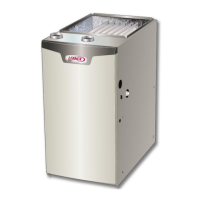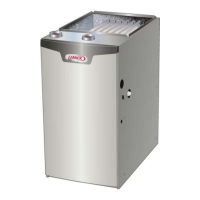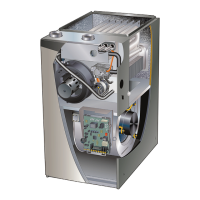Page 6
cient and safe operation. You must consider combustion
air needs and requirements for exhaust vents and gas
piping. A portion of this information has been reprinted
with permission from the National Fuel Gas Code (ANSI.
Z223.1/NFPA 54). This reprinted material is not the com-
plete and ofcial position of the ANSI on the referenced
subject, which is represented only by the standard in its
entirety.
In Canada, refer to the CSA B149 installation codes.
CAUTION
Do not install the furnace in a corrosive or contaminated
atmosphere. Meet all combustion and ventilation air
requirements, as well as all local codes.
All gas-red appliances require air for the combustion
process. If sufcient combustion air is not available, the
furnace or other appliance will operate inefciently and
unsafely. Enough air must be provided to meet the needs
of all fuel-burning appliances and appliances such as ex-
haust fans which force air out of the house. When replac-
es, exhaust fans, or clothes dryers are used at the same
time as the furnace, much more air is required to ensure
proper combustion and to prevent a downdraft. Insuf-
cient air causes incomplete combustion which can result
in carbon monoxide.
In addition to providing combustion air, fresh outdoor air
dilutes contaminants in the indoor air. These contaminants
may include bleaches, adhesives, detergents, solvents
and other contaminants which can corrode furnace com-
ponents.
The requirements for providing air for combustion and
ventilation depend largely on whether the furnace is in-
stalled in an unconned or a conned space.
Unconned Space
An unconned space is an area such as a basement or
large equipment room with a volume greater than 50 cubic
feet (1.42 m3) per 1,000 Btu (.29 kW) per hour of the com-
bined input rating of all appliances installed in that space.
This space also includes adjacent rooms which are not
separated by a door. Though an area may appear to be
unconned, it might be necessary to bring in outdoor air
for combustion if the structure does not provide enough air
by inltration. If the furnace is located in a building of tight
construction with weather stripping and caulking around
the windows and doors, follow the procedures in the Air
from Outside section
Conned Space
A conned space is an area with a volume less than 50
cubic feet (1.42 m3) per 1,000 Btu (.29 kW) per hour of
the combined input rating of all appliances installed in that
space. This denition includes furnace closets or small
equipment rooms.
When the furnace is installed so that supply ducts carry
air circulated by the furnace to areas outside the space
containing the furnace, the return air must be handled by
ducts which are sealed to the furnace casing and which
terminate outside the space containing the furnace.This
is especially important when the furnace is mounted on
a platform in a conned space such as a closet or small
equipment room.
Even a small leak around the base of the unit at the plat-
form or at the return air duct connection can cause a po-
tentially dangerous negative pressure condition. Air for
combustion and ventilation can be brought into the con-
ned space either from inside the building or from outside.
Air from Inside
If the conned space that houses the furnace adjoins a
space categorized as unconned, air can be brought in by
providing two permanent openings between the two spac-
es. Each opening must have a minimum free area of 1
square inch (645 mm2) per 1,000 Btu (.29 kW) per hour of
total input rating of all gas-red equipment in the conned
space. Each opening must be at least 100 square inches
(64516 mm2). One opening shall be within 12 inches (305
mm) of the top of the enclosure and one opening within 12
inches (305 mm) of the bottom. See Figure 4.
EQUIPMENT IN CONFINED SPACE - ALL AIR FROM INSIDE
OPENINGS
(To Adjacent
Unconfined
Space)
NOTE - Each opening shall have a free area of at least one square inch
per 1,000 Btu (645mm
2
per .29kW) per hour of the total input rating of
all equipment in the enclosure, but not less than 100 square inches
(64516mm.
2).
ROOF TERMINATED
EXHAUST PIPE
SIDE WALL
TERMINATED
EXHAUST PIPE
(ALTERNATE
LOCATION)
EL296UH
V
Figure 4

